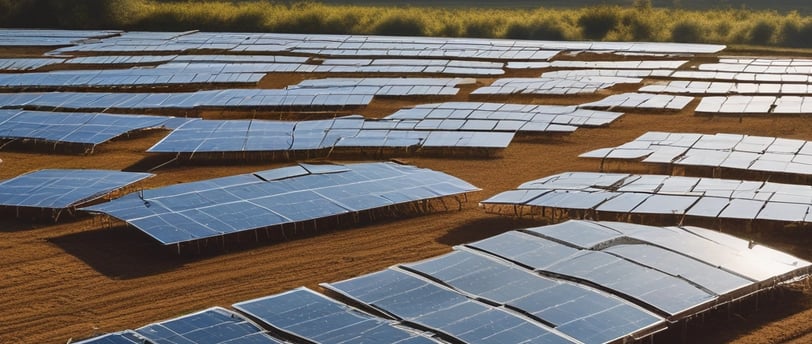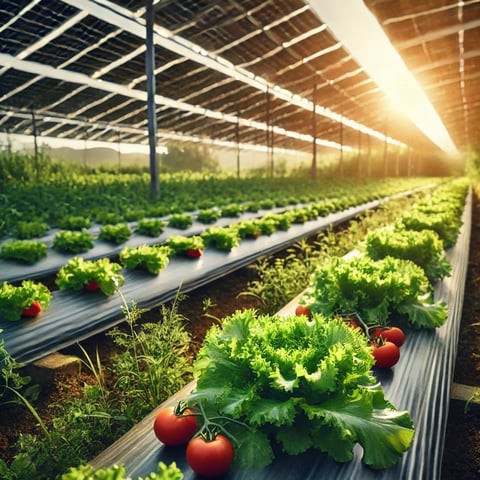Introduction to Agrivoltaics
Agrivoltaics represents an innovative synergy between agricultural land use and solar energy production, combining these two essential components to enhance sustainability and resource efficiency. This multi-faceted approach allows for the simultaneous cultivation of crops while harnessing solar power. As the global demand for energy continues to escalate alongside the urgent need to address climate change, agrivoltaics has garnered increasing attention from researchers, farmers, and policymakers alike.
The essence of agrivoltaics lies in its ability to optimize land use. Traditionally, agricultural activities and energy production have occupied separate territories, resulting in potential inefficiencies and land degradation. By integrating solar panels into farmland, this method not only maximizes land utility but also offers an avenue for agricultural productivity to coexist with renewable energy generation. This integration can lead to improved crop yields, as the shade provided by solar panels can reduce heat stress for certain crops, thereby enhancing their resilience to climate-induced challenges.
The growing interest in agrivoltaics is significantly driven by the rising urgency for sustainable practices. As climate change intensifies, the agricultural sector faces formidable challenges, including water scarcity, soil degradation, and fluctuating weather patterns. Agrivoltaics emerges as a strategic response to these issues, facilitating farmers' adaptation to changing environmental conditions while creating renewable energy sources. This dual-use model can contribute positively to reducing greenhouse gas emissions and promoting energy independence while ensuring consistent food production.
In summary, agrivoltaics stands out as a promising solution for addressing both agricultural demands and energy needs. By further exploring the mechanics and potential benefits of this approach, stakeholders can better understand how agrivoltaics can lead to resilient and sustainable practices for future generations.
How Agrivoltaics Works
Agrivoltaics represents an innovative synergy between agriculture and solar energy production, utilizing land efficiently for both food cultivation and clean energy generation. The core mechanism revolves around installing solar panels at strategic heights above crops, allowing for optimal sunlight exposure for both plants and solar photovoltaic systems. Typically, these systems are designed with a vertical spacing that ensures adequate sunlight penetrates to the crops below while maximizing the solar energy harvested. This approach not only conserves land but also enhances the productivity of both sectors.
The configuration of agrivoltaic systems is paramount. Solar panels are often mounted on adjustable frames that can tilt or rotate, optimizing their angle towards the sun throughout the day and across seasons. This adjustability is crucial for balancing the competing needs of solar energy collection and agricultural crop growth, ensuring that neither is compromised. The spacing between rows of solar panels is also carefully calculated, as tight arrangements can lead to shading problems, drastically affecting crop yield. Research indicates that spacing can vary significantly depending on the types of crops featured, with taller plants requiring more clearance from panels.
Moreover, certain crops exhibit a remarkable resilience and adaptability to agrivoltaic conditions. Vegetables such as leafy greens, which thrive in partial shade, can not only exist but flourish under solar installations. Additionally, fruits and other shade-tolerant plants can benefit from the microclimate created by solar panels, which can help reduce temperature extremes. This dynamic interaction promotes biodiversity and resilience in agricultural systems while facilitating sustainable solar energy production. By leveraging technology and nature, agrivoltaics stands at the forefront of agricultural innovation, promising enhanced food security and energy sustainability.
Benefits of Agrivoltaics for Land Use
Agrivoltaics presents a transformative approach to land use management by integrating agricultural practices with solar energy generation. This dual-use model enhances land efficiency, allowing farmers to cultivate crops while simultaneously generating renewable energy. Traditionally, agricultural land has been designated solely for food production, but agrivoltaics challenges this notion by optimizing space utilization and yielding higher productivity per acre.
By adopting agrivoltaics, farmers can benefit from increased economic resilience. The ability to produce both crops and energy can diversify income streams, reducing reliance on singular agricultural outputs. In regions experiencing fluctuating market prices or adverse weather, agrivoltaics can serve as a buffer, ensuring a continuous revenue flow even when traditional agricultural outputs might be compromised. Moreover, solar panels provide partial shading for crops, which can reduce heat stress and potentially extend the growing season, resulting in a higher volume and diversity of crops.
Environmental benefits are also significant. Agrivoltaic systems can mitigate issues related to land degradation and loss of arable land, a pressing concern in modern agriculture. The installation of solar panels can minimize soil erosion and encourage better water retention, ultimately enhancing soil health. Additionally, by occupying previously unused or degraded lands, agrivoltaics can help preserve untouched ecosystems and biodiversity. This approach counteracts the increasing pressure from urban development and industrialization that threatens agricultural land.
In conclusion, agrivoltaics represents an innovative solution that combines energy generation with sustainable agricultural practices. As global populations continue to rise and the demand for food and energy escalates, implementing agrivoltaics can provide significant benefits in land use, ensuring efficient and responsible management of resources for future generations.
Impact on Crop Yields and Water Conservation
Agrivoltaics, the co-deployment of agriculture and solar photovoltaic systems, has emerged as an innovative solution to enhance crop yields while addressing pressing water conservation challenges. By positioning solar panels above crops, this dual-use approach creates favorable microclimates that can significantly influence agricultural productivity. Research has shown that the shade provided by solar panels can mitigate the harsh effects of extreme temperatures, allowing crops to flourish in otherwise stressful conditions.
The protective effects of this overhead shading are manifold. Firstly, the reduction in direct sunlight exposure helps prevent heat stress in plants, which can lead to improved growth conditions and higher yield potential. Studies have demonstrated that crops such as tomatoes and peppers exhibit enhanced fruit quality and quantity when shielded from excessive sunlight. Furthermore, the presence of solar panels can contribute to a more stable soil temperature, promoting optimal root development and nutrient uptake.
Another critical advantage of agrivoltaics lies in its impact on water conservation. By reducing the rate of soil evaporation, the combination of solar panels and crops can lead to significant water savings. Research indicates that the installation of agrivoltaics may lower evaporation rates by approximately 50%, compared to traditional farming practices. This not only conserves water resources but also enables farmers to allocate their water supply more efficiently, particularly in arid regions where water scarcity is prevalent.
In light of these benefits, agrivoltaics presents a viable strategy for enhancing agricultural sustainability and resilience. The integration of solar energy generation with crop production not only helps mitigate the impacts of climate change on agriculture but also promotes better resource management. As farmers increasingly adopt this innovative approach, the potential for improved crop yields and optimized water usage will undoubtedly contribute to the ongoing transition toward more sustainable agricultural practices.
Economic Advantages for Farmers
The integration of agrivoltaics in agricultural practices presents significant economic advantages for farmers. By enabling the simultaneous cultivation of crops and the generation of solar energy, agrivoltaic systems provide a unique opportunity for farmers to diversify their revenue streams. This dual production model allows farmers to reap the benefits of both agricultural output and energy sales, enhancing overall profitability.
In many regions, the installation of solar panels on agricultural land does not hinder crop yield; rather, it may enhance it by providing shade to plants, potentially improving water retention and reducing heat stress during warm months. This can result in healthier crops and increased yields, which translates into higher income for farmers. Furthermore, farmers can sell any excess energy produced back to the grid, creating an additional source of income. This has proven to be particularly beneficial during periods of price volatility in agricultural markets, as income from energy production can help stabilize overall revenue.
Government incentives play a crucial role in the adoption of agrivoltaic systems. Many countries offer grants, tax credits, and subsidies to support the installation of renewable energy systems. These financial incentives can significantly reduce the initial investment required for farmers, making the transition to agrivoltaics more feasible. Additionally, various agricultural programs emphasize sustainable practices and may reward farmers who adopt innovative technologies that contribute to environmental stewardship.
Moreover, agrivoltaics can lead to reduced operational costs in the long term. By harnessing solar energy for their own needs, farmers can decrease reliance on external energy sources, subsequently lowering utility expenses. These combined economic benefits illustrate how agrivoltaics can serve as a viable strategy for enhancing farm profitability and resilience, ultimately securing a more sustainable future for the agricultural sector.
Challenges and Considerations in Agrivoltaics Implementation
The integration of agrivoltaics into existing agricultural practices presents various challenges and considerations that stakeholders must navigate. One of the primary concerns is the initial investment costs. Establishing agrivoltaic systems generally involves significant capital required for solar panel installation, land modification, and the potential need for new irrigation systems. Farmers and investors need to carefully evaluate the financial viability of such projects, taking into account not just the upfront costs but also long-term operational expenses and maintenance requirements.
Site selection criteria play a crucial role in the successful implementation of agrivoltaics. Not all agricultural lands are suitable for solar panel installation. Factors such as land slope, soil quality, and existing vegetation must be assessed to ensure that solar panels do not adversely affect crop growth. Furthermore, careful attention must be paid to local regulations and zoning laws, which may impose restrictions on land use. Engaging with local authorities early in the process can help mitigate potential legal issues down the line.
Logistical challenges are another vital consideration. The simultaneous operation of agricultural activities and solar energy generation means that appropriate planning is essential to avoid interference between the two. This may include scheduling the maintenance of solar panels when crops are not being tended to, ensuring adequate access for both farming equipment and solar maintenance teams. Additionally, there is an ongoing need for research into optimal crop and solar panel combinations to maximize both energy production and agricultural yield, fostering a mutually beneficial relationship between farming and solar energy. Addressing these challenges head-on will be essential for the successful adoption of agrivoltaics.
The Future of Agrivoltaics
The potential of agrivoltaics to address the pressing challenges of food security and energy sustainability is both promising and essential. As global population levels continue to rise, the demand for food will inevitably increase, making it imperative to explore innovative agricultural practices. Agrivoltaics presents a unique solution that integrates solar energy production with crop cultivation, enabling farms to benefit from dual land use. According to research, the implementation of agrivoltaics can significantly enhance land efficiency, providing farmers with additional income through energy generation while simultaneously improving crop yields through optimized microclimate conditions.
Emerging technologies are playing a crucial role in the advancement of agrivoltaics. Innovations such as bifacial solar panels that capture sunlight from all angles, and smart sensor technologies that optimize water and nutrient delivery, are revolutionizing the way we approach solar energy within agricultural settings. Additionally, advancements in energy storage solutions are critical, allowing farmers to save excess energy produced during peak sunlight hours for later use. Such technologies make agrivoltaics increasingly viable, offering a sustainable path forward as the agriculture and energy sectors converge.
Moreover, policy developments at both the local and global levels are expected to amplify the growth of agrivoltaics. Governments are starting to recognize the potential benefits of this dual approach to land use and are increasingly incentivizing its adoption through subsidies and grants. By creating regulatory frameworks that support agrivoltaic projects, policymakers can encourage investment in this sustainable practice. Stakeholders, including farmers, energy producers, and investors, must collaboratively harness the potential of agrivoltaics to address climate change and boost food security. The future of agrivoltaics is bright, and it calls for immediate action and investment to realize its full potential.













